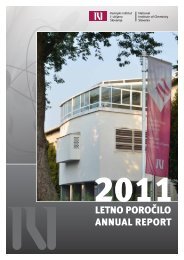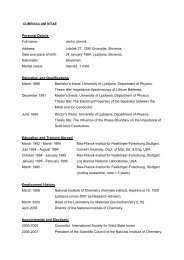Letno poročilo 2005
Letno poročilo 2005
Letno poročilo 2005
Create successful ePaper yourself
Turn your PDF publications into a flip-book with our unique Google optimized e-Paper software.
zanemarljivo majhne hlapnosti in mo`nosti<br />
prevajanja razli~nih ionskih zvrsti. V primeru<br />
Grätzlovih celic predstavljajo alternativo<br />
obi~ajnim ionskim elektrolitom z vklju~enimi<br />
redoks I - -<br />
/I pari. Za delo programske skupine<br />
3<br />
pa predstavljajo nadgradnjo redoks elektrolitov,<br />
narejenih na osnovi organsko-anorganskih<br />
hibridov po postopkih sol-gel kemije, in<br />
to zato, ker zaradi njihove zanemarljive<br />
hlapnosti odpade potreba po tesnenju<br />
Grätzlovih celic. Ionske teko~ine za Grätzlove<br />
celice so znane le 6 let in od takrat je bila<br />
narejena vrsta elektrolitov, ki so potrdili, da<br />
je raziskave v tej smeri vredno nadaljevati,<br />
nakazali pa so tudi, da predstavlja tesnenje<br />
celic {e vedno problem. Od tod je le korak do<br />
uporabe ionskih teko~in, ki bi imeli kvazi trdno<br />
ali gelsko strukturo. Problem smo re{ili tako,<br />
da smo sintetizirali ionsko teko~ino (1-metil-<br />
3-¢3-(trimetoksi-λ4-silil)propil¥imidazolijev jodid), ki je imela na imidazolijevem kationu<br />
pripete trietoksi skupine, ki so omogo~ile,da<br />
ionska teko~ina kondenzira v kvazi trdno<br />
stanje ¢B. Orel et al., Electrochem. Commun.<br />
7, 692 (<strong>2005</strong>); V. Jovanovski et al., J. Phys.<br />
Chem. B 109, 14387 (<strong>2005</strong>); B. Orel et al., J.<br />
Nanosci. Nanotehnol. (v tisku)¥.<br />
- Protonsko prevodne membrane smo razvijali<br />
v okviru Apollon EU projekta (vodja S.<br />
Ho~evar). Poizkusi na membranah v gorivnih<br />
celicah potekajo naprej, dodatne rezultate pa<br />
bomo objavili v letu 2006 ¢U. Lavren~i~<br />
[tangar, J. Solid State Electrochem. 9, 106<br />
(<strong>2005</strong>)¥.<br />
- Karbamatosilne nanokompozite smo uporabili<br />
v obliki gelov za pripravo redoks<br />
elektrolitov, ki omogo~ajo delovanje hibridnih<br />
elektrokromnih sklopov ¢V. Jovanovski,<br />
Organosilicon Chemistry, 2, 967 (<strong>2005</strong>)¥.<br />
Prednost redoks elektroklitov je v tem, da<br />
ustrezni elektrokromni sistemi ne potrebujejo<br />
proti elektrod. Z vklju~evanjem ionske<br />
teko~ine smo dosegli trajno elasti~nost<br />
nanokompozita, do odhlapevanja reakcijskih<br />
produktov ni pri{lo; k temu je pripomogla tudi<br />
Laboratorij za spektroskopijo materialov<br />
Laboratory for Spectroscopy of Materials<br />
provements were made for the V 2 O 5 films<br />
with the addition of organic-inorganic hybrid<br />
to the initial sol of Vanadium isopropoxide<br />
precursor ¢M. Liberatore, Sol. Energy<br />
Mater. Sol. Cells 90, 434 (2006)¥. The<br />
light vision of the interior of buildings<br />
equipped with “smart” windows colouring<br />
were quantified, revealing that the continuous<br />
variation of the light impinging through<br />
“smart” window led to the inversion of the<br />
colour space (Fig. 1). These types of study<br />
are not known and were published for the<br />
first time ¢M. Klanj{ek Gunde, J. Opt. Soc.<br />
Am. A, Opt. Image. Sci. Vis. 22, 416 (<strong>2005</strong>)¥.<br />
- Ionic liquids attracted interest worldwide in<br />
the last few years mainly because of their<br />
negligible vapour pressure, low toxicity and<br />
ability to conduct various ions, which open<br />
their applications as electrolytes for various<br />
electrochemical devices (batteries and DSPEC<br />
cells). We succeeded to prepare an ionic liquid<br />
showing self-condensation properties,<br />
avoiding the leakage problems encountered<br />
with the ordinary ionic liquids. The condensation<br />
of the ionic liquid was achieved by<br />
making 1-methyl-3-¢3-(trimethoxy-λ4-silyl) propyl¥imidazolium iodide, characterized by<br />
the trialkoxysilane groups enabling the solgel<br />
reactions, which led to the formation of<br />
positively charged silsesquixane condensation<br />
products having an open polyhedra structure<br />
(POSS) ¢B. Orel et al., Electrochem. Commun.<br />
7, 692 (<strong>2005</strong>); V. Jovanovski et al., J. Phys.<br />
Chem. B 109, 14387 (<strong>2005</strong>); B. Orel et al., J.<br />
Nanosci. Nanotehnol. (in press)¥.<br />
- Proton conducting membranes were synthesized<br />
and applied in low-temperature fuel<br />
cells. This work was done in the frame of our<br />
collaboration in EU Project Apollon (S.<br />
Ho~evar) ¢U. Lavren~i~ [tangar, J. Solid State<br />
Electrochem. 9, 106 (<strong>2005</strong>)¥.<br />
- The work published in ¢V. Jovanovski,<br />
Organosilicon Chemistry, 2, 967 (<strong>2005</strong>)¥ represents<br />
an alternative approach towards the<br />
preparation of electrochromic devices with a<br />
47







